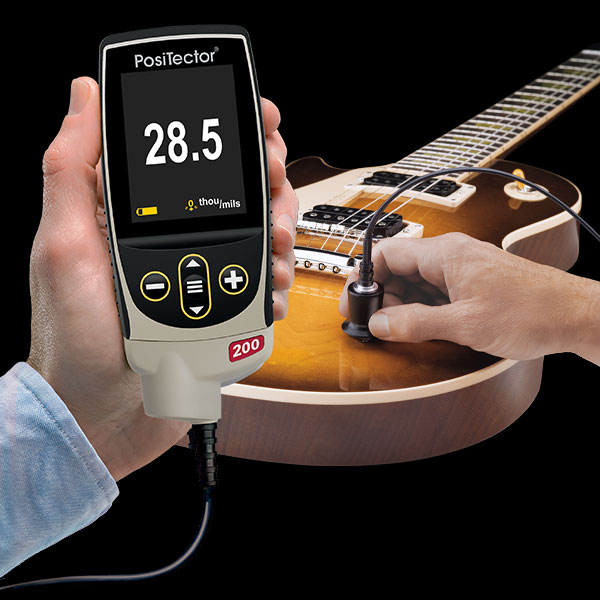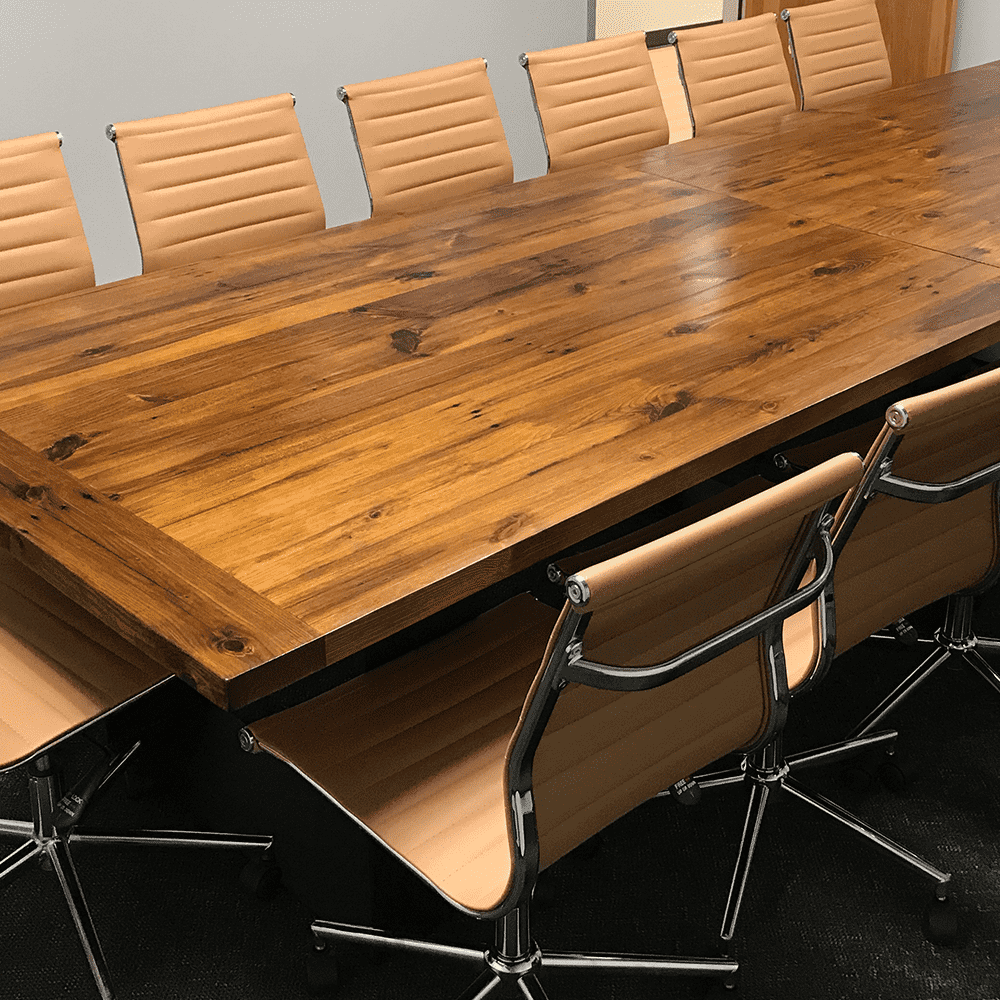In Part 1 of this article, we covered the definition, importance, and measurement of wet film thickness. Today, we’ll do the same for dry film thickness.
As important as wet film thickness is, “the total thickness of the film finish when dry” is equally important. This (in bold) is the definition of dry film thickness.
Simply explained, if it is too thin, its performance will suffer (poor durability and protection, improper sheen, poor UV protection, etc.). And depending on the finish, if it’s too thick, over time it may crack or become cloudy.
Calculating Dry Film Thickness
First, just for FYI purposes…
If your volume and type of work requires a LOT of ultra-fast and ultra-accurate measurements, ultrasonic coating thickness gauges do exist for wood coatings, such as the one shown below. They can range in price from a few hundred to a few thousand dollars.

The traditional and less expensive way to determine the total dry thickness of a coating is to first measure its wet film thickness then multiply the result by the percentage of solids by VOLUME. The equations looks like this:
Dry Film Thickness = Wet Film Thickness (mils) x %Volume of Solids
Note: most finish manufacturers only provide percentages of solids by weight. That said, if you’re using water-based finishes, the difference between volume and weight is usually less than a few percentage points and therefore negligible for our purposes.
However, for solvent-based finishes, you should be using only volume percentages, as the difference between volume and weight in these finishes is usually too high to disregard (up to a 20% difference in many cases).
Ok, back to our formula…
As we said, you first measure the coating’s wet film thickness, then multiply the result by the percentage of solids by volume. The resultant sum of all coats will equal the approximate total dry film thickness.
Again, manufacturers will usually provide the minimum (and sometimes maximum) recommended dry film thickness, or the equivalent number of coats. If you cannot find out what the optimal dry thickness should be for the finish you’re wanting to use, I recommend a minimum of 2.5 mils and in all cases, no more than 5mils.
To help you visualize this more easily, let’s use as an example Target Coatings EM8000 conversion varnish.
Assuming you have applied all coats at the recommended 2 mils thickness, and given the stated 34% of solids by weight, you come up with .64 mils thickness per coat. Multiply that by the number of coats (four) they used in the KCMA-type test, and the dry thickness of the topcoat equals 2.56 mils.
Finishing is one of the most exciting parts of any project for me, just as I hope it will be for you. By understanding film thickness and its importance to achieving terrific finish results, and applying that knowledge, I believe your finish quality will improve.
If you have any comments on this topic, or recommendations for future topics, please share your thoughts or read what others are saying in the comments section below. I’m here for you.
Marty Schlosser has nearly 50 years experience as a furniture designer, maker, and finisher, including a career in production-level spray finishing. Often called, “the industry’s go to expert,” Marty is a past-president of the Ottawa Woodworkers Association (and a proud recipient of their Danny Proulx Memorial Award), and the founding member of Kingston Wood Artisans, a local woodworking club in Kingston, Ontario, Canada where he and his wife reside.


Thanks for doing these Marty! I have not sprayed much. Recently I had success with EM6000 at 3-4 mil, but problems with EM8000 trying to do 1-2 mil as it calls for. It seemed to come out rough, like textured or powder-coated. It looked to me like it could not wet and flow out. To get a wetted coat that wasn’t rough or showing patches of different texture, I am sure it was more like 4 mil or more. Of course that is taking forever to dry, so I have particles in it now. I tried thinning 5%, which sounded like the max recommended, but didn’t really see a difference. I am filtering through the FujiSpray reusable coarse filter, which is supposed to be 70 um, and using a MiniMite 5 Platinum and T75G with 1.3 mm nozzle. I am doing this outdoors in northern California, like 60 F. The time in the viscosity cup for the unthinned EM8000 was 49 seconds, which seems slow compared to the 6000 (which I did not measure). Maybe I am spraying too fine or too far away?
Any ideas or help would be appreciated.
Where does any documentation call for 1-2 mil coats with EM8000cv?
The TDS (https://www.targetcoatings.com/wp-content/uploads/2016/03/TC_TechDataSheet_EM8000CV_R3.pdf) doesn’t actually specify a recommended coating thickness. It does note that the KCMA results were for “4 2-mil coats”, but it specifies the per-coat drytime and spread rate for 3-mil coats. I had always inferred from those two data that the recommended range was 2-3 mils, and I get good results when I aim within that range.
I don’t think you could spray a good 1-mil coat of EM8000 without thinning it more than is recommended, but more competent finishers than I might manage it. The only time I aim for 1 mil with a Target finish is when shooting flash coats of EM1000 at 1:1 dilution (note, don’t even think about trying that with EM1K at full strength). The respective TDS do allow 1:1 dilution for the clear lacquers when used as sealers or tie coats, so you could probably get close to 1 mil with those, too.
You’re right that the EM8000 datasheet doesn’t specify a dry-film thickness limit, and that’s probably why Marty used the language “I recommend …”, making it clear that this is his practice and not Target’s specification. In my experience it’s generally understood that catalyzed finishes branded as “conversion varnishes” tend to accumulate internal stresses and shouldn’t go much thicker than ~5 mils dry. Generally finish makers will say that there is “no limit” for finishes that can go much thicker than that. For examples see the EM6000 and EM7000 datasheets.
Since we’re griping about TDS inconsistencies, note also that the EM8000cv datasheet’s recommended concentration range for CL100 conflicts with the CL100 product page (5-10% vs 3-6% IIRC).
Nate, Patrick and Marty – I believe the confusion regarding the dry-film thickness requirements of the EM8000cv stems from a KCMA test result that is posted on the EM8000cv TDS. This TDS was written back in 2017, and at that time my test centered around a specific test that I created for a client that required me to follow KCMA test guidelines based on the clients specifications. To clarify the matter, the EM8000cv does not have a maximum number of coats that can/cannot be applied. The unique aspect of the EM8000cv formula as it was developed back in 2010 allows the coating to be applied over itself and/or over various types of sanding sealers. With this said, my verbal guidelines to customers who inquire into the best practices for EM8000cv use is to apply an average of 3 to 4 coats at 2 to 3mils wet per coat. I hope this information helps to clear the air.
As a side note: All Emtech TDS are currently being updated to match the newly revised formulas that are now being released for the EM2000, EM6000, EM7000 and EM8000. These new variations range from minor tweaks to a complete overhaul of resin design. These upgrades are – by near force majeure – due to the restriction (and near collapse) of resin manufacturing sources throughout the North America and the EU in mid-2020 courtesy of the COVID-19 lockdowns. The systematic shutdowns by the major acrylic and urethane resin manufacturers forced not just Target Coatings, but also my allied manufacturers and customers as well as my competition to retool our formulas. I don’t think a single coatings manufacture was spared by these shortages and cancellations. As this smoke begins to clear many of us in the paint/coatings mfg business are beginning to suspect that several suppliers eliminated or severely curtailed the release of resins to reduce their range or products for many reasons, those of which I will keep to myself.
So, with this ramble I would like to state that I personally burned a lot of midnight hours at the lab bench in the need to reformulate my products. The lemons that were served to me by my suppliers has, as the saying goes – forced me to make some really kickass lemonade! I am very pleased with the upgrades, and I am confident that these new versions of my venerable line of products will keep Target Coatings on the forefront of technically advanced waterborne coating systems. Thanks for your continued support.
-JW-
Thanks for the info Marty. According to numerous data sheets for Target Coatings clear coat products, I was under the impression that there is no limit to the number of coats that could be applied. This article appears to say the opposite (unless I’m misunderstanding).
The only Target top-coat datasheets that explicitly say there is no limit are the ones for the clear lacquers (EM6000 and EM7000).
In my experience going very thick with anything branded as a “conversion varnish” is asking for trouble, though not having tried EM8000cv at >5 mils I don’t know how it performs. And even if I had my experience wouldn’t necessarily apply to you.
My broader experience with finishes in general is that there is almost always something of a tradeoff between maximum film thickness as limited by cracking/checking on the one hand, and attributes like mechanical durability and chemical resistance on the other. That’s true for lacquers, where pre- and post-cats are less tolerant of high builds than are ordinary nitros. It’s also true of most 2K conversion varnishes that I’ve seen (most of which are not at all tolerant of excessive build). It would not surprise me at all if EM6K and EM7K really are the most accommodating of the Target formulations as their datasheets suggest.
There’s also an element of “it depends” here, since the amount of environmental variability, the stability of the substrate, and the behaviors of underlying layers (if any) in the coating stack all play a big role.
It would be interesting to hear Jeff’s thoughts on this.